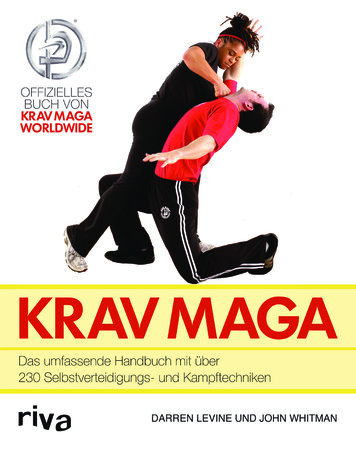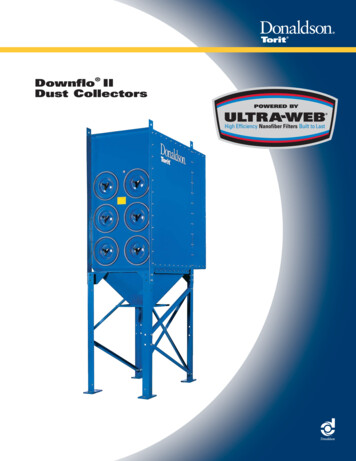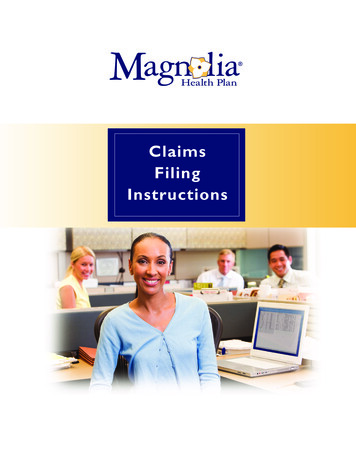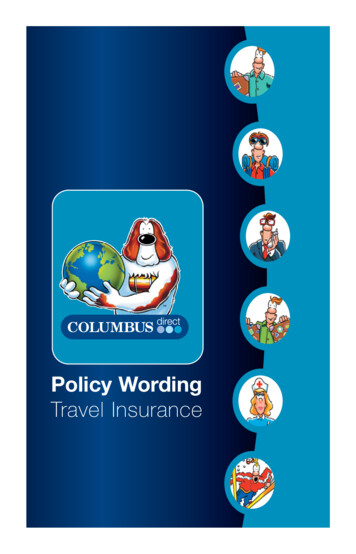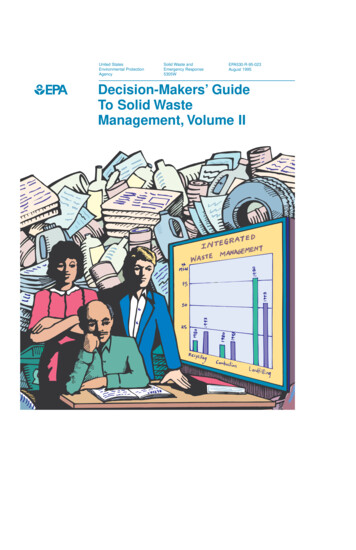
Transcription
D-MCOVER.QXD7/2/96 10:35 AMPage 1United StatesEnvironmental ProtectionAgency1EPASolid Waste andEmergency Response5305WEPA530-R-95-023August 1995Decision-Makers’ GuideTo Solid WasteManagement, Volume II
EPA/600/Decision Maker's Guide to Solid Waste Management, Volume IIProject Co-Directors:Philip R. O’LearyPatrick W. WalshSolid and Hazardous Waste Education CenterUniversity of Wisconsin–ExtensionandDepartment of Engineering Professional DevelopmentUniversity of Wisconsin–Madison432 North Lake StreetMadison, WI 53706Cooperative Agreement No. CX-817119-01Office of Solid Waste (5306)Municipal and Industrial Solid Waste DivisionU.S. Environmental Protection Agency401 M Street, SWWashington, D.C. 204681995Printed on Recycled Paper
Page ii
DECISION MAKER'S GUIDE TO SOLID WASTE MANAGEMENT—Vol. II PREFACE The Decision Maker's Guide to Solid Waste Management, Vol. II hasbeen developed particularly for solid waste management practitioners, such as local government officials, facility owners and operators, consultants, and regulatory agency specialists. The Guidecontains technical and economic information to help these practitioners meet the daily challenges of planning, managing, and operating municipal solid waste (MSW) programs and facilities.The Guide's primary goals are to encourage reduction of waste atthe source and to foster implementation of integrated solid wastemanagement systems that are cost-effective and protect humanhealth and the environment.Because the infrastructure and technology for handling MSWare rapidly changing, the information presented should help decision makers consider the numerous factors associated with successful implementation of new solid waste management solutions. Readers are encouraged to carefully evaluate all of the elements in their waste-handling systems and implement source reduction, recycling, and environmentally sound disposal.Communities are encouraged to coordinate their goals forwaste reduction and management, environmental protection,community development, and employment. Communities, businesses, institutions, and individuals should apply their creativityand ingenuity in drafting policies and designing programs thatprevent the generation of waste in the first place. When wastegeneration is unavoidable, the materials can be viewed as a resource from which reusable materials, raw feedstock, minerals,organic matter, nutrients, and energy can be recovered for beneficial uses. Residual materials requiring disposal must be carefullymanaged to protect human health and the environment.We encourage all individuals involved with MSW management to expand their professional skills and to help other practitioners and community members better understand the challenges we face and the opportunities available to us. It is primarily through such cooperative enterprises that governments, communities, and businesses can make the best possible decisions forthe reduction and management of municipal solid waste. From: Decision Maker’s Guide to Solid Waste Management, Volume II, (EPA 530-R-95-023), 1995.Project Co-Directors: Philip R. O’Leary and Patrick W. Walsh, Solid and Hazardous Waste EducationCenter, University of Wisconsin-Madison/Extension. This document was supported in part by theOffice of Solid Waste (5306), Municipal and Industrial Solid Waste Division, U.S. EnvironmentalProtection Agency under grant number CX-817119-01. The material in this document has beensubject to Agency technical and policy review and approved for publication as an EPA report.Mention of trade names, products, or services does not convey, and should not be interpreted asconveying, official EPA approval, endorsement, or recommendation.Page iii
DECISION MAKER'S GUIDE TO SOLID WASTE MANAGEMENT—Vol. II PREFACE(continued)A Note on Using This GuidebookFor a quick overview of the issues covered in each chapter, readers are encouraged to review the highlights presented at the beginning of each chapterand the margin notes appearing throughout the Guide.DisclaimerThis document was supported in part by the U.S. Environmental ProtectionAgency under grant number CX-817119-01. The material in this documenthas been subject to Agency technical and policy review and approved forpublication as an EPA report. Mention of trade names, products, or servicesdoes not convey, and should not be interpreted as conveying, official EPAapproval, endorsement, or recommendation.Page iv
DECISION MAKER'S GUIDE TO SOLID WASTE MANAGEMENT—Vol. II AC KN OWLED GMEN TS The Decision Maker's Guide to Solid Waste Management, Volume II wasprepared under agreement between the Wisconsin Environmental ProtectionAgency (EPA) and the Solid and Hazardous Waste Education Center at theUniversity of Wisconsin-Madison/Extension. The authors and theirUniversity of Wisconsin campus affiliations are shown below:Philip R. O’LearyPatrick W. WalshRobert K. HamSherrie G. GruderMary G KohrellHolly J. JohnsonWayne PferdehirtAga S. RazviEngineering Professional Development, UW-MadisonAgricultural Engineering, UW-MadisonCivil and Environmental Engineering, UW-MadisonCooperative Extension, UW-MadisonNatural and Applied Science, UW-Green BayNatural Resources, UW-Stevens PointEngineering Professional Development, UW-MadisonSolid Waste Management, UW-Stevens PointGary L. Boley authored Chapter 8, "Combustion." Additional materials wereprepared by Andrew Swartz and Sue Waite. The document was edited andplaced in camera ready-form by Christina Komadina. Jill McCulley and MeredithMcIntosh assisted in proof reading the final document. Kris Winneke providedprogram support. The document was reviewed by staff of the Municipal andIndustrial Solid Waste Division(MISWD.)EPA and the authors wish to acknowledge the assistance of the followingsolid waste experts who served as a peer review team or prepared written reviewsof individual chapters:Kathy Berg MoegerJan BeyeaFrank CrossDiana GaleRobert GlebsFrancis R. GouinRichard HaysTimothy Hunt, Jr.Ronald LofyWilliam P. MooreJohn NutterRon PolandPaul RelisTom RichardGary SondermeyerRobert L. SpencerMinnesota Office of Waste Management, St. Paul, MNNational Audubon Society, New York CityCross/Tessitore & Associates, P.A., Orlando, FLSeattle Solid Waste Utility, Seattle, WACostain Resource Management, Inc., Madison, WIUniversity of Maryland at College Park, College Park, MDWaste Management Department, City of San Diego, CASolid Waste Authority of Palm Beach County, FLLockman and Associates, Monterey Park, CAPaper Recycling International, Norcross, GAAmerican Recovery Corporation, Washington, D.C.Laidlaw Waste Systems, Burlington, OntarioCommunity Environmental Council, Santa Barbara, CACornell University, Ithaca, NYNew Jersey Department of Environmental Protection,Trenton, NJEnvironmental Planning Consultants, Dalton, MAPage v
DECISION MAKER'S GUIDE TO SOLID WASTE MANAGEMENT—Vol. IIPage vi
DECISION MAKER'S GUIDE TO SOLID WASTE MANAGEMENT—Vol. II CONTENTS Preface .iiiAcknowledgments .vContents .viiFigures .xixTables .xxiiIntroduction.xxvEMERGING ISSUES . xxviREFERENCES . xxviiChapter 1: Public Education and InvolvementINTRODUCTION . 1-1HIGHLIGHTS . 1-2A PUBLIC EDUCATION PLAN . 1-3Awareness . 1-4Interest . 1-5Evaluation . 1-6Trial . 1-6Adoption . 1-8Maintenance . 1-9INTRINSIC INCENTIVES . 1-9EXTRINSIC INCENTIVES . 1-10THE PUBLIC INVOLVEMENT PLAN . 1-10THE ISSUE EVOLUTION-EDUCATIONAL INTERVENTION (IEEI) MODEL . 1-10REFERENCES . 1-13Chapter 2: Facility SitingINTRODUCTION . 2-1HIGHLIGHTS . 2-2THE SITING PROCESS . 2-4Creating a Siting Strategy . 2-4Who Is the Public? . 2-4Including the Public in the Process . 2-7Techniques for Involving the Public . 2-8Communicating Risks More Effectively . 2-8Building Credibility for Technical Information . 2-13Addressing Negative Impacts, Both Perceived and Real . 2-14Evaluating the Effectiveness of the Siting Strategy . 2-14Page vii
DECISION MAKER'S GUIDE TO SOLID WASTE MANAGEMENT—Vol. II CONTENTS(continued)THE PERMITTING PROCESS . 2-15The Structure and Goals of the Permitting Process . 2-15Solid Waste Management Activities Requiring Permits . 2-16Source Reduction Programs . 2-16Recycling . 2-16Composting . 2-16Waste-to-Energy . 2-17Landfilling . 2-17Collection and Transport . 2-17REFERENCES . 2-17Chapter 3: Factors to ConsiderINTRODUCTION . 3-1HIGHLIGHTS . 3-2DEVELOPING THE NECESSARY INFORMATION BASE . 3-4Identify Goals and Scope of the Program . 3-4Characterize Quantity and Composition of Material . 3-4MODELLING TECHNIQUES . 3-5Generic Weight Generation Data . 3-5Generation Rates For Specific Waste Types . 3-6Landfill Volume Estimates . 3-7PHYSICAL TECHNIQUES . 3-8Sampling Techniques . 3-8DIRECT MEASUREMENT TECHNIQUES . 3-8ESTIMATING THE PERCENTAGE OF MATERIAL THAT MUST BE MANAGED . 3-9Legal Control Over Waste Materials . 3-9Personal Waste Management . 3-11ESTIMATING FUTURE WASTE GENERATION . 3-11Gauging Program Participation and Effectiveness . 3-11ORGANIZING A WASTE MANAGEMENT PROGRAM . 3-14Planning . 3-14Price . 3-15Publicity . 3-15Politics . 3-15Perseverance . 3-16REFERENCES . 3-16Chapter 4: Collection and TransferINTRODUCTION . 4-1HIGHLIGHTS . 4-2DEVELOPING A SOLID WASTE COLLECTION AND TRANSFER SYSTEM . 4-5DEFINING COMMUNITY GOALS AND CONSTRAINTS . 4-5CHARACTERIZING WASTE TYPES, VOLUMES, AND THE SERVICE AREA . 4-6PUBLIC AND PRIVATE COLLECTION/TRANSFER: DETERMINING OPTIONS . 4-6Page viii
DECISION MAKER'S GUIDE TO SOLID WASTE MANAGEMENT—Vol. II CONTENTS(continued)DETERMINING THE SYSTEM FUNDING STRUCTURE . 4-7IDENTIFYING WASTE PREPARATION AND COLLECTION PROCEDURES . 4-10Solid Waste Set-Out Requirements . 4-10Storage Container Specifications . 4-10Solid Waste Separation Requirements . 4-11Frequency of Collection . 4-11Pick-up Points for Collection . 4-11DETERMINING COLLECTION EQUIPMENT AND CREW SIZE . 4-13Selecting Collection Equipment . 4-13Equipment Types . 4-13Criteria for Equipment Selection . 4-14Crew Size . 4-14EVALUATING TRANSFER NEEDS AND OPTIONS . 4-14Evaluating Local Needs for Waste Transfer . 4-16Types of Transfer Stations . 4-16Small to Medium Transfer Stations . 4-16Larger Transfer Stations . 4-17Direct-Discharge Noncompaction Stations . 4-17Platform/Pit Noncompaction Stations . 4-18Compaction Stations . 4-19Transfer Station Design Considerations . 4-19Site Location and Design Criteria . 4-19Building Design . 4-20Transfer Station Sizing . 4-20Additional Processing Requirements . 4-23Transfer Vehicles . 4-24Trucks and Semitrailers . 4-24Rail Cars . 4-24EVALUATING COLLECTION AND TRANSFER ALTERNATIVES . 4-26Defining System Alternatives . 4-26Comparing Alternative Strategies . 4-26Analyzing Crew and Truck Requirements . 4-26Estimating Time Requirements . 4-27Loading Time Requirements . 4-27Hauling Time and Other Travel Time Requirements . 4-27Overall Time Requirements . 4-28Analyzing Transfer Elements . 4-28Selecting A Collection and Transfer Alternative . 4-28DEVELOPING COLLECTION ROUTES AND SCHEDULES . 4-30Heuristic Route Development: A Manual Approach . 4-31Computer-Assisted Routing . 4-32IMPLEMENTING THE COLLECTION AND TRANSFER SYSTEM . 4-32Finalizing and Implementing the System Management Plan . 4-32Purchasing and Managing Equipment . 4-33Equipment Purchasing . 4-33Equipment Maintenance . 4-33Equipment Replacement . 4-34Hiring and Training Personnel . 4-34Safety . 4-34Comfort . 4-35Training . 4-35Page ix
DECISION MAKER'S GUIDE TO SOLID WASTE MANAGEMENT—Vol. II CONTENTS(continued)Worker Incentives . 4-35Developing and Managing Contracts with Labor Unions and Private Collectors . 4-36Providing Public Information . 4-36MONITORING SYSTEM COSTS AND PERFORMANCE . 4-37REFERENCES . 4-37Chapter 5: Source ReductionINTRODUCTION . 5-1HIGHLIGHTS . 5-2UNDERSTANDING AND FOSTERING SOURCE REDUCTION . 5-5Defining Source Reduction . 5-5Source Reduction as a First-Choice Approach . 5-6Measuring Source Reduction . 5-6SOURCE REDUCTION POLICY . 5-7Regulation . 5-7Economic Incentives and Disincentives . 5-9GOVERNMENT SOURCE REDUCTION . 5-10Facility Source Reduction Programs: Performing Waste Audits . 5-10Purchasing . 5-11COMMERCIAL (INDUSTRIAL AND BUSINESS) SOURCE REDUCTION . 5-13Source Reduction Implementation Guidelines For Industries . 5-14Manufacturing Redesign . 5-14Product Redesign . 5-14Other Industrial Source Reduction Strategies . 5-15Designing for Durability . 5-15Designing for Reuse . 5-15Designing Products to Facilitate Repair . 5-15Source Reduction Implementation Guidelines For Businesses . 5-15Other Examples of Source Reduction and Reuse by Businesses . 5-17SOURCE REDUCTION BY RESIDENTS . 5-18Local Source Reduction Economic Incentives: Unit-Based Garbage Fees . 5-18Yard Material Reduction . 5-19Consumer-Based “Precycling” or “Eco-Shopping” . 5-20REFERENCES . 5-22Chapter 6: RecyclingINTRODUCTION .
DECISION MAKER'S GUIDE TO SOLID WASTE MANAGEMENT—Vol. II Page iii PREFACE The Decision Maker's Guide to Solid Waste Management, Vol. II has been developed particularly for solid waste management practi-tioners, such as local government officials, facility owners and op-erators, consultants, and regulatory agency specialists. The Guide


